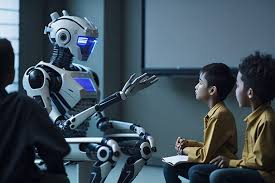The AI Classroom: Redefining Learning and Teaching in a New Era

The classroom of the future isn't a distant vision. It is already here. A high school student in a rural classroom in China receives instant, personalized feedback on a physics problem from an AI tutor.
while a teacher in the US uses an AI tool to generate a week’s worth of lesson plans in minutes, freeing up her afternoon to mentor struggling students. The integration of AI into education is moving at an unprecedented pace.
It is fundamentally changing the roles of both students and teachers. AI offers immense potential to personalize learning, improve accessibility for diverse students, and free up teachers' time for more meaningful human interaction.
It also raises critical questions about equity, data privacy, and the preservation of critical thinking skills.
The New Tools of Learning and Teaching
AI tools like automated tutors and lesson planners are being implemented in classrooms across different countries, redefining the educational experience.
The global market for AI in education is projected to reach an impressive $30.28 billion by 2029, with over 47% of education leaders already using AI daily. This growth is fueled by a range of innovative platforms.
SOURCE: Google
In South Korea, AI tutors are widely used to provide customized learning paths for students. These systems, like those from companies such as Squirrel AI and Century Tech, adapt to each student’s pace and learning style.
Globally, AI platforms are being used to help teachers with lesson planning and administrative tasks. AI can instantly generate quizzes, create customized worksheets, and even grade essays, significantly reducing a teacher's workload.
SOURCE: Guardian
Platforms like Eduaide.ai are designed specifically for this purpose, helping teachers create everything from graphic organizers to assessments in minutes. These tools free teachers from repetitive, time-consuming tasks.
It allows them to focus on the human aspects of teaching. This includes mentorship, classroom discussions, and addressing the social and emotional needs of their students.
The Ethical AI Classroom: Concerns and Debates
While the promise is great, there are primary ethical concerns surrounding AI in education. Issues of data privacy, algorithmic bias, and the potential for a "digital divide" are at the forefront of the debate. AI educational tools collect vast amounts of data on students.
This includes their learning patterns, test scores, and even emotional responses to content. This raises serious questions about who owns this data, how it is secured, and who has access to it. As stated in a report by The World Economic Forum, a data breach could expose highly sensitive personal information.
SOURCE: The World Economic Forum
There is also the risk of algorithmic bias. If an AI’s learning model is trained on data from a narrow demographic, it may not be effective for all students, potentially reinforcing existing social biases in assessments and recommendations.
This can lead to an unfair distribution of educational resources. Furthermore, the digital divide remains a significant concern. Not all students have equal access to devices, reliable internet, or the digital literacy required to use these tools effectively. This could further entrench educational inequalities, rather than closing them.
The Evolving Role of the Teacher
The introduction of AI is fundamentally redefining the role of a teacher. They are becoming facilitators of learning rather than simply dispensers of information.
With AI handling repetitive tasks, teachers can transition to being mentors and guides, helping students navigate complex information and fostering essential soft skills like critical thinking, collaboration, and creativity.
The new emphasis is on human-centered skills. AI can teach a student a fact. But a human teacher can inspire a student to love learning. The teacher's role is shifting towards creating a supportive and engaging classroom environment. It is about fostering deep understanding and emotional intelligence, skills that AI cannot replicate.
As explained by Northeastern University, teachers will become experts in integrating technology and interpreting the data from AI tools to inform their instruction. They will be able to pinpoint exactly where students are struggling and provide targeted, human intervention.
A New Set of Skills for a New World
The world is rapidly changing with the constant presence of artificial intelligence, and education is transforming to meet this new reality. The focus is shifting away from a traditional model that emphasized rote memorization to a dynamic curriculum centered on critical thinking, problem-solving, and a new form of digital literacy.
The overarching goal is to prepare students to be not just consumers of technology, but creators and critical users who can thrive in an AI-powered society.
This shift means students are learning to do more than simply use AI tools; they are learning to question their outputs, understand their limitations, and biases. Instead of accepting information at face value, students are trained to act as detectives, evaluating AI-generated responses for accuracy and ethical considerations.
For example, a history assignment might require students to use an AI to summarize an event, but then task them with identifying any potential biases in the AI's account and cross-referencing it with primary sources. This cultivates a deep level of analytical thought that goes far beyond simple information recall.
Educators are now placing a strong emphasis on new skills like prompt engineering and data interpretation. Prompt engineering is the art of crafting precise, effective instructions to get the best possible output from an AI.
This skill teaches students to think strategically about how they frame problems and ask questions, moving from a simple search query to a multi-layered command that yields a more nuanced result.
Alongside this, data interpretation has become paramount. While AI can generate vast amounts of data in seconds, the human skill of analyzing that data, finding patterns, and drawing meaningful conclusions from it is more valuable than ever.
Students are learning to critically examine AI-generated data sets, identify correlations, and use them to support their own evidence-based arguments.
Finally, the assessment of these new skills is also evolving. Traditional tests, which often measure memorization, are being supplemented with project-based learning and portfolio assessments that require genuine creativity and collaboration.
Instead of a written exam, students might be tasked with creating a documentary, building a chatbot, or designing a complex solution to a real-world problem. These projects often integrate AI as a collaborative tool for brainstorming or research, but the final product showcases the student’s unique ingenuity and intellectual ownership.
This new approach to assessment ensures that what is being taught is what is truly being measured—a student’s ability to think, create, and collaborate in an increasingly complex world.
The Policy Frontier
Governments and educational institutions are developing a range of policies and guidelines to ensure the responsible and effective use of AI. This includes creating ethical frameworks that prioritize equity, transparency, and data privacy. The European Commission has released guidelines for teachers on using generative AI, emphasizing the need for critical evaluation of content generated by AI.
SOURCE: European Commission
Many school districts are also implementing clear policies. These policies define what constitutes academic honesty in an age of AI and how to ensure fair and unbiased use of AI tools. These policies are essential for building a framework of trust and accountability.
They are also needed to ensure that the transformative power of AI is harnessed for the good of all students. The challenge is immense. But the opportunity to create a more personalized, equitable, and effective education system is equally so.
Recommended Articles
US Government Greenlights Advanced Nvidia AI Chip Exports to China
President Donald Trump has authorized Nvidia to sell advanced H200 AI chips to approved customers in China, a move inten...
Nvidia AI Chips: Trump Opens Floodgates for China Sales
Former President Donald Trump authorizes Nvidia H200 AI chip sales to approved Chinese customers, raising debates over ...
Tech Giant Surge: Google's Alphabet Eyes Staggering $4 Trillion Valuation Milestone

Alphabet is poised to reach a $4 trillion valuation, driven by soaring cloud business and advancements in AI, notably wi...
SoftBank Founder Masayoshi Son Rocked by $5 Billion Net Worth Plunge Amid Stock Tumble

SoftBank Group CEO Masayoshi Son's net worth took a nearly $5 billion hit as the company's shares plummeted over 10% due...
Regulatory Alarm: Federal Reserve Eyes 'Guardrails' Amid Financial Sector's AI Surge

Federal Reserve Governor Michael Barr emphasized the critical need for clear guardrails to manage risks as the financial...
Elon Musk's Trillion-Dollar Payday Hangs in Balance as Tesla Shareholders Vote

Tesla shareholders are voting on Elon Musk’s record-breaking trillion-dollar pay package, a pivotal decision that could ...
You may also like...
Arsenal Legend Thierry Henry to Receive Prestigious BBC Lifetime Achievement Award

Former Arsenal and France football legend Thierry Henry will be honored with the Lifetime Achievement award at the 2025 ...
Maresca's Emotional Rollercoaster: Chelsea Boss Claims 'Happy' After 'Worst 48 Hours'

Chelsea boss Enzo Maresca has clarified his previous 'worst 48 hours' comments, now expressing happiness and a deeper co...
Fallout Season 2 Shatters Records, Outperforming HBO's Last of Us!

Fallout Season 2 has premiered on Prime Video to overwhelmingly positive critical and audience reception, scoring a near...
Winter Is Back! Kit Harington Hints at Massive Game of Thrones Comeback

Kit Harington has definitively shut down any possibility of reprising his role as Jon Snow, stating he doesn't want to g...
Love Blossoms: Anwuli & Kennedy's Instagram Romance Leads to #HappilyEverOffor!

Anwuli and Kennedy's love story, sparked by an Instagram connection, led to a beautiful Igbo traditional wedding. After ...
Teyana Taylor & Lucien Laviscount Light Up the 'Spirit Tunnel' with Epic Dance Moves!

The Jennifer Hudson Show features high-energy 'Spirit Tunnel' entrances, with Lucien Laviscount making a stylish walk an...
Kenya's Billion-Shilling Travel Bill: Austerity Pledge Broken?

The Kenyan government spent nearly Sh5 billion on travel in the first three months of FY 2025/26, raising concerns about...
Shehu Sani Urges Nigerians: Shun US Travel Ban, Build Nation

The United States has enacted new travel restrictions impacting Nigerian nationals, covering both immigrant and several ...
.png&w=1920&q=75)